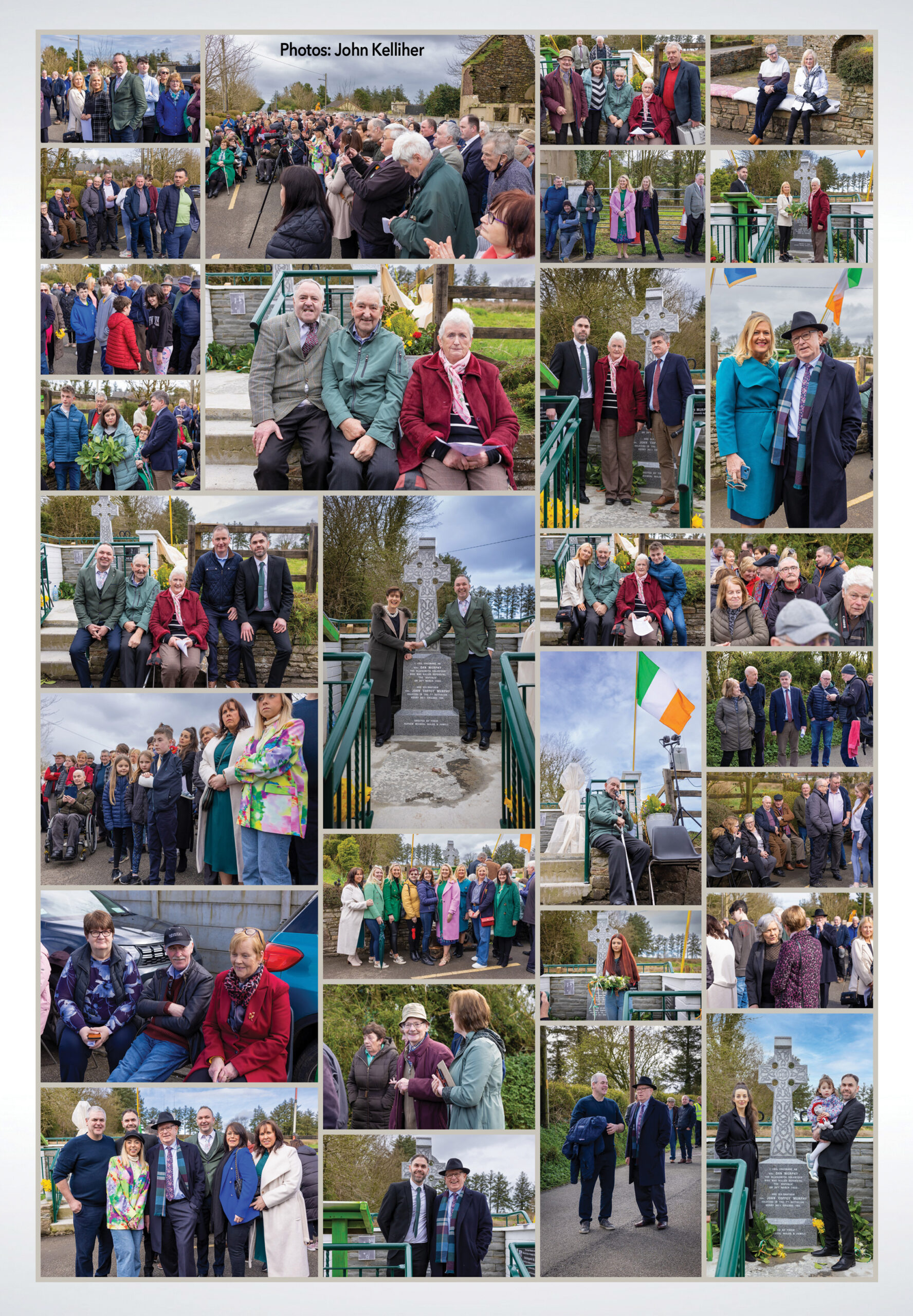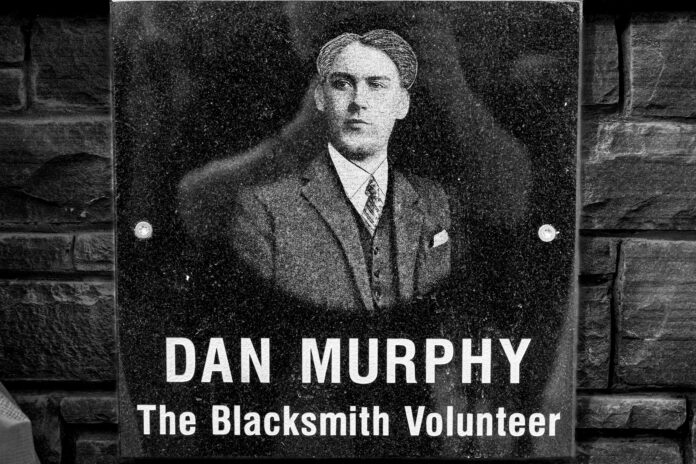Dan Murphy ‘The Blacksmith Volunteer’ and his comrades are remembered in Knocknagoshel on the Centenary of his Murder.
Over 400 people crowded into Knocknagoshel Village last Saturday the 25th March for The Centenary Commemoration for Dan Murphy ‘The Blacksmith Volunteer’.
Dan, a member of The Irish Republican Army, was wrongly murdered by The Irish Free State Army on March 24th 1923. He was shot at least 20 times at the site of a republican mine explosion at Burke’s Field in Knocknagoshel, where on March 6th 1923 five members of The Free State Army died. Determined to capture the Volunteers of The Knocknagoshel Battalion, a large Free State party raided Dan’s house at 6am on March 24th. Dan had been on the run but had arrived back in Knocknagoshel village the previous evening. He stayed in the family home on the night of March 23rd, even though he had received a warning from Free State Army Captain Con Brosnan from Moyvane that both Dan and his brother John’s lives were in danger. He informed a pro-Treaty supporter Dave Leahy in the village that the Dublin Guard were determined to kill them and should not be in the village around that time. Dan was due to go to his sister Bridget’s house in Maugha on the morning of March 24th, where at this remote location near Lyreacrompane he would have been safe. Unfortunately it was too late, as that morning both Dan and John were detained and their forge was searched. The Freestaters found nothing, though there was a large quantity of ammunition hidden in a trough.
The brothers were tortured and interrogated but neither would say anything, and following hours of heavy-handed brutality the Free State Officers decided that Dan was to be executed. They accused Dan of constructing the mine in his forge and would exact revenge on at least one of the brothers. Dan did not make the metal casing of the mine as he had been on the run at the time. The mine was manufactured in The Murphy Forge by his brother John. Dan was bound by his captors and marched from the village and over to the field at the site of the explosion. Free State Officers Jeremiah Gaffney, Maurice Culhane and William McAuliffe became judge, jury and executioners. They opened fire on Dan and the shooting was witnessed by local girl Bridie Lyons. She reported seeing Dan Murphy standing tall before his killers, who shot him several times. He fell but managed to get himself up on his elbows. He was then shot again at close range.
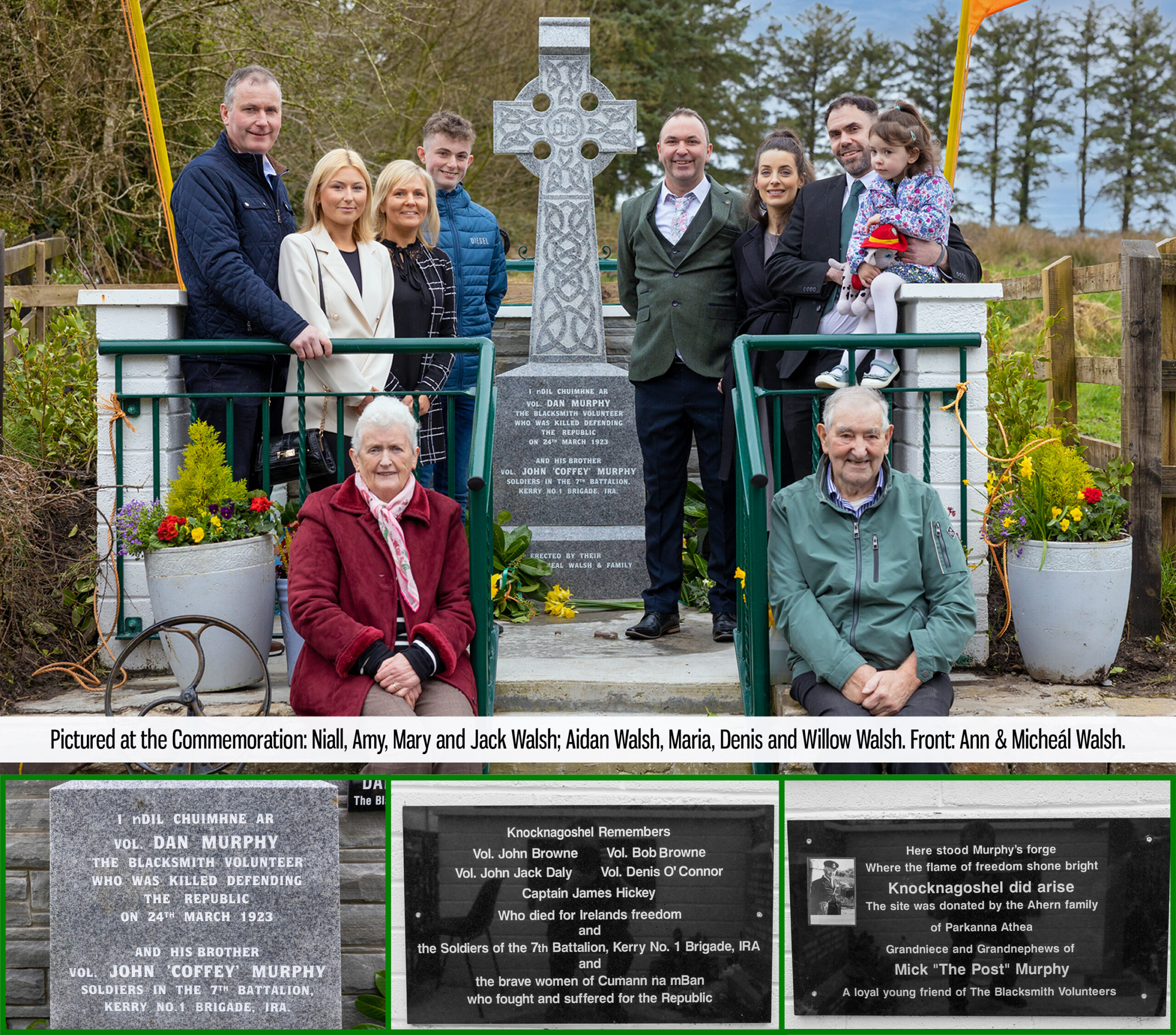
This centenary event was organised by Micheál Walsh, a nephew of Dan Murphy. Included in the ceremony was the unveiling of a Monument dedicated to Dan Murphy. Dan Murphy’s brother John is also listed on the monument, though he wasn’t killed during this time, however he was an active member of The IRA. There was also an unveiling of a Plaque dedicated to the five other Local Volunteers who lost their lives for Irish freedom and another Plaque to The Women of Cumann na mBan.
Grand-nephew of Dan Murphy, Denis Walsh was chairman for the event and opened with the lines: “While many, would like us to forget some of the terrible events around the Civil War… we are here to remember and commemorate the great men and women who suffered and died in defence of The Irish Republic, declared in 1916.”
The national flag was then raised by Evan Walsh, great grand-nephew of Dan and John Murphy and The Cumann na mBan Flag was raised by Evan’s sister Robyn.
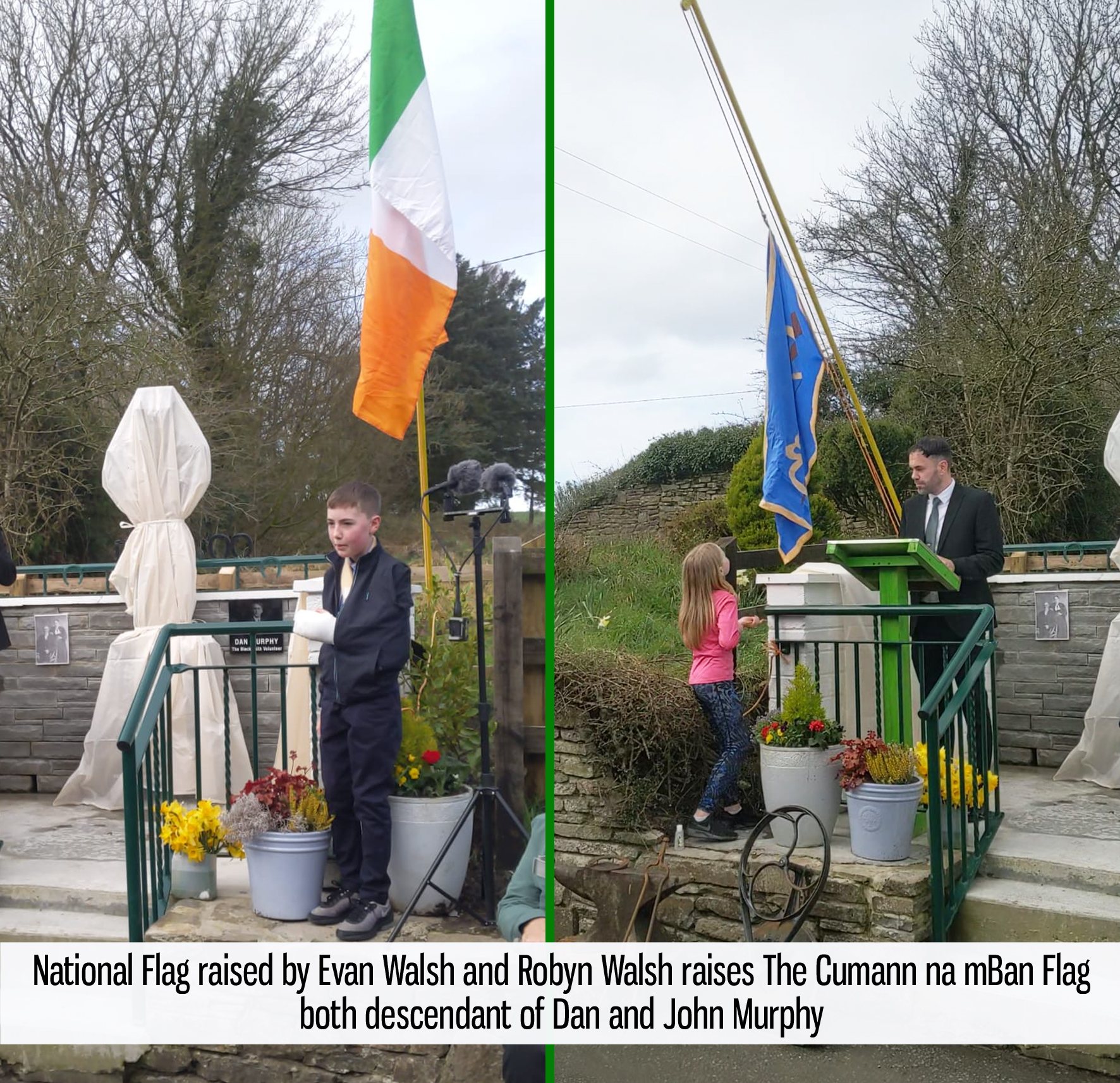
Following the raising of the flags Denis spoke about the importance of the event: “There are similar commemorations happening in parts of the country at present to remember people and incidents of probably the worst time in our history. However, what makes this one more significant, is that it marks the first plaque being unveiled to the memory of Cumann na mBan. “As we remember these heroes, it is essential to do so, truthfully. The Civil War brought with it a government sponsored Freestate Army that were just as cruel and vicious as many of Irelands previous oppressors such as The Black and Tans. The Freestaters were enforcers of the terms of the Treaty, which kept Ireland within the British empire. They were an army… unrestrained by neither the laws of God nor man. Thankfully as of now, even though they have tried, we do not have commemorations or tributes to The Black and Tans in Ireland, but knowing the history of some of The Freestaters brutality…one wonders why they share tributes with the republicans of that time. There is no equivalence between the defenders of the Republic and those who sought to destroy it.”
“The Irish had previously endured the brutality of the Tans only for Dan and the other republicans to have to face this tyranny, yet again. The heavy hand of the government with the help of foreign forces… a cruel irony of in 100 years how so much has changed… yet so much has remained the same.”
Denis continued and spoke about the signing of The Anglo-Irish Treaty and suggested that given the violence and division that carried on for decades after, perhaps the signing of this treaty by Michael Collins was the greatest mistake in the history of this country. “That treaty was presented to The Irish people as a stepping stone towards freedom, a long stepping stone indeed. These stepping stones quickly became gravestones, of that of Dan and many others. What of Michael Collin’s legacy now – how many are proud to be a descendant of a Freestater and how many are proud to be a descendant of a Republican.”
Denis explained how the republicans at the time were up against an impossible task given that The Freestate Army were funded by The Irish and British Governments. However, he did say that the republicans fight was not in vain as the horrendous events inflicted on republicans after the mine explosion began to change public opinion. The cold blooded murders perpetrated by Free State Officers on Republicans at Ballyseedy, Countess Bridge and Cahersiveen in the aftermath of Knocknagoshel had swayed worldwide opinion, to sympathise with the Republicans’ plight. A ceasefire was declared not long after so while the volunteers in Knocknagoshel, would have at times, felt their cause to be futile, they did bring about the beginning of the end of The Civil War.
The next speaker was Micheál Walsh, nephew of Dan and John Murphy. He gave an emotional account of the events that led up to the mine explosion in Knocknagoshel. He started by saying: “With this huge turnout today, anyone who thinks republicanism is dead in Kerry is making a bad mistake.” He explained the barbarity of The Free State forces and how they brutally terrorised any republican house in the village.
He said: “The Free State Army terrified many households in Knocknagoshel at the time and the Republicans knew they needed to do something to stop it. The mine explosion in Knocknagoshel had nothing to do with what happened at Ballyseedy, Countess Bridge or Cahersiveen. The people of Knocknagoshel were just standing up for themselves.”
Micheál also called for the autopsy results on Michael Collins to be released, as the historic account of Collins’ death does not match the viewpoint of many historians today. “Can we get Dail Eireann to release the autopsy of Michael Collins so we can really find out what happened.” He believes that it was someone in Michael Collins’ company that shot him at close range before Collins had a chance to come to some agreement with Eamon De Valera. Micheál was also fervent in requesting that the records of the events at Ballyseedy, Countess Bridge and Cahersiveen be changed in The Dail to reflect the true history. “Stephen Fuller survived the explosion at Ballyseedy and told the truth so The Dail needs to change these records so future generations can know the truth. The complete lack of enthusiasm to set these records straight is unbelievable.”
Micheál received a rapturous round of applause for the way he spoke and for his work in making sure these lost heroes were rightly remembered in the village.
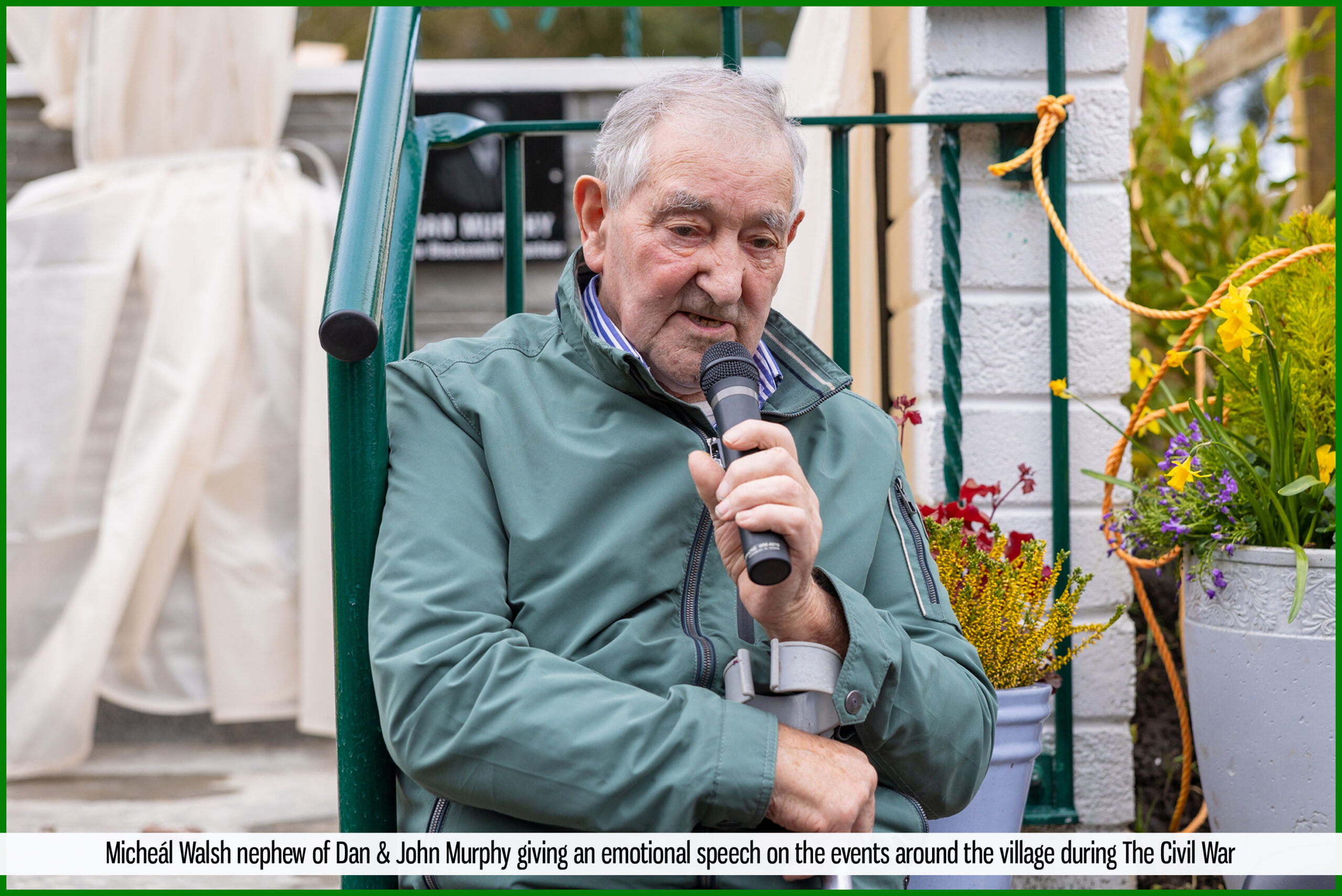
The unveiling of the monument was done by Aidan Walsh, another grand-nephew of Dan Murphy. Aidan had the following words to say before the cloak was pulled on a beautiful monument: “It is a great honour to open this here today for my grand-uncle Dan Murphy, one hundred years after his death. Anyone would be proud to have heroes like Dan Murphy in their ancestry. It is a poignant fact that The Murphy name, of that family from one hundred years ago, has not carried through to today in the locality. A scenario that may well have been different, had Dan not given his life for the 32 counties of Ireland. But with this monument Dan Murphy and the Murphy name will sit proud at the top of this village forever more.”
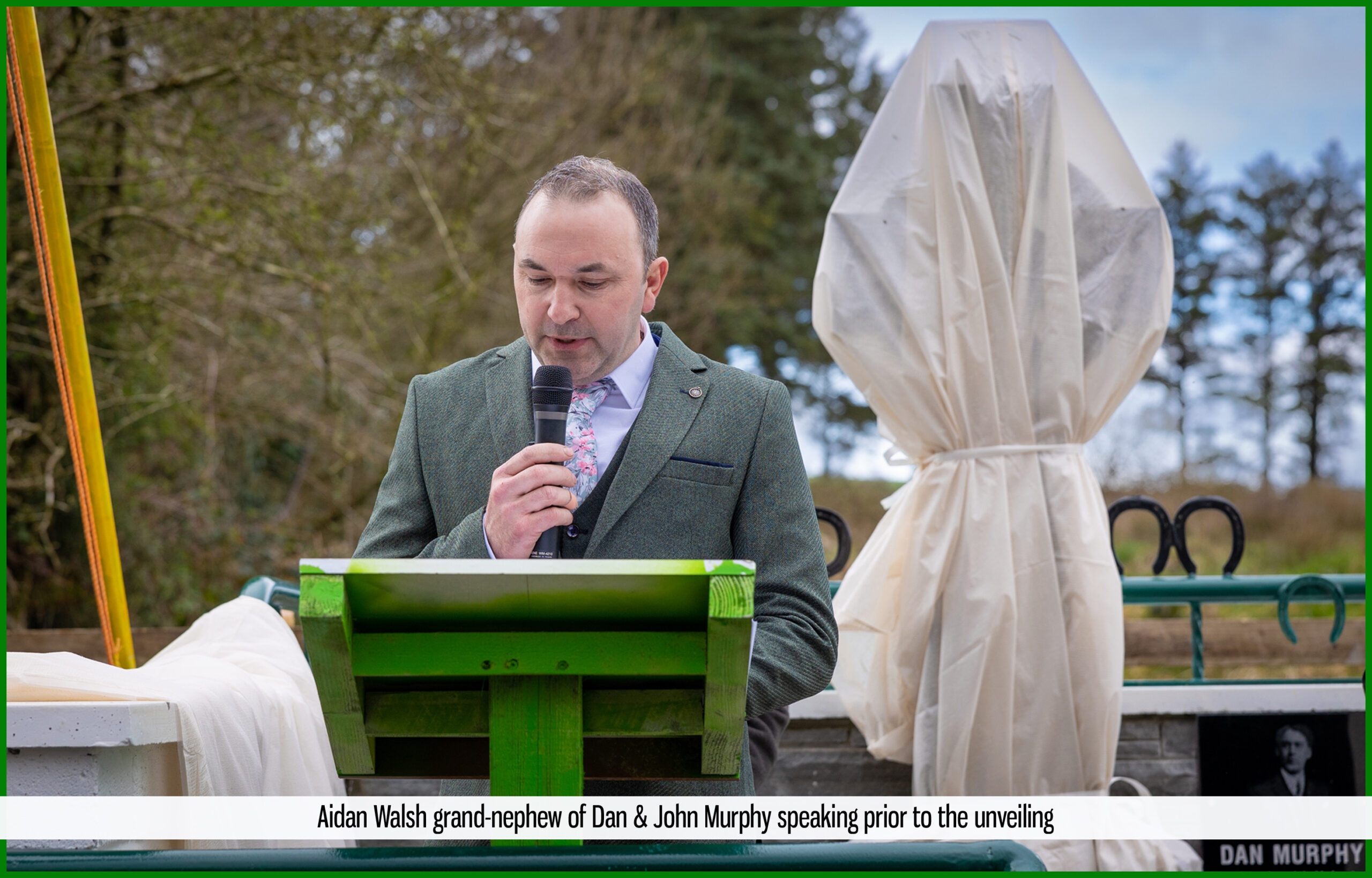
Wreaths were then laid in remembrance of Dan Murphy, John Murphy and their Mother Katie, done by Micheál Walsh, The Walshe Family from The Forge (Deirdre, Danny, Marie and Fiona) and Katie Walsh respectively. Niamh Walsh, great-grand niece of Denny O’Connor laid a wreath for the five other volunteers from the village who lost their lives around this time; Denny O’Connor, John Jack Daly, John and Bob Browne and Captain James Hickey. Wreaths were also laid for the Women of Cumann na mBan by Amy and Ann Walsh. The final wreath was laid to Mick The Post Murphy by his grand-nephew Seamus Ahern. Mick was a dear friend of The Murphys at the time and Seamus Ahern donated the site for the monument.
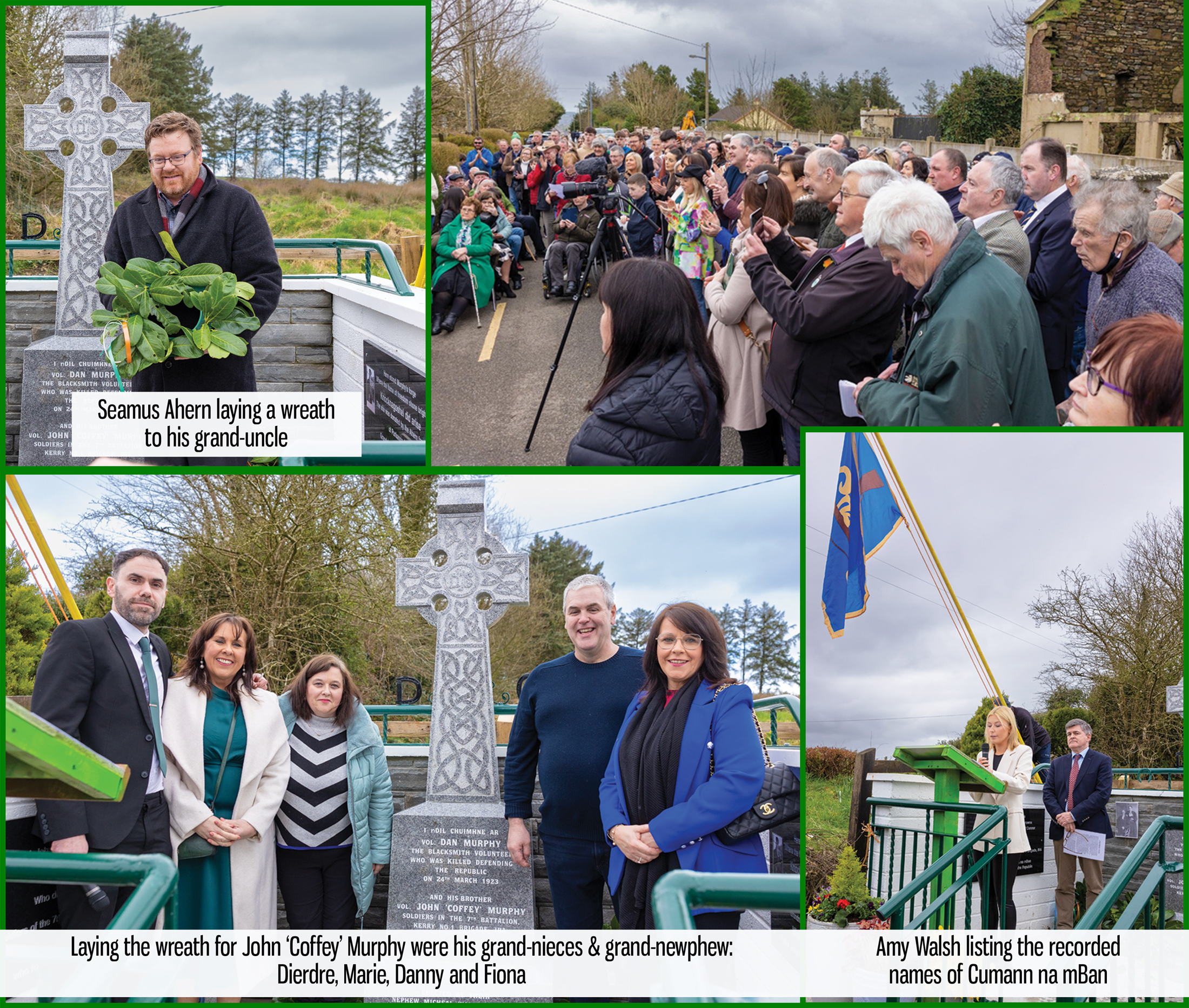
The next speaker to be introduced by Denis Walsh was Dr. Tim Horgan from Tralee who has four books published on the 1916 – 1923 period in County Kerry, each chapter of which records the stories of the ordinary men and women who fought for freedom… over a century ago. Many of these patriots might have otherwise slipped from the pages of Ireland’s history and have been forgotten. His grandmother, Madge Clifford of Firies, was a significant figure in the republican movement of the day. She was at the Rink in Tralee in 1916 when the expected Rising was called off. Madge was a member of the Four Courts garrison at the outset of the Civil War, the only Kerry person to be in the Four Courts. Later, she was secretary to Liam Lynch, the chief of staff of the Republican forces during the Civil War and served as Quartermaster General of Cumann na mBan during that conflict.
Dr. Tim Horgan assisted the Walsh family with and he spoke the following words on the role of Cumann na mBan in the struggle for national independence: “Our liberty was not something benignly bestowed on us by Britain. Because it would not be given, it was necessary to take it. Ireland was for centuries held for the Crown by military might and unfortunately it could not be wrenched from Britain’s clutches except by force of arms. The people of Ireland would raise an army but it would be an army without banners, without uniforms and with few weapons. It would be an army of volunteers, an army of the people and an army representing the people. As women constituted half the population, it was fitting that women too would play their role in the fight for national independence. While the Irish Volunteers were established in Dublin in November 1913, women’s section of the republican army, Cumann na mBan, was founded five months later in April 1914.”
“Rapidly throughout the land, the rise of the Irish Volunteer movement was mirrored by the formation of Cumann na mBan branches. In the 1916 Rising, its members would play a prominent role. Its leaders names have entered the history books; Constance Markievicz, Margaret Skinnider, Nurse Elizabeth Farrell, Ada English and many more. Three years later, as war against the British commenced again, Cumann na mBan was stronger than ever. While the names of some prominent national members have been recalled in our national narrative, the stories of the vast majority of those heroic women have been forgotten, nudged from history by a state which had little respect for their gender and great suspicion of their ideals. Even today, the state refuses to call the new children’s national hospital after Dr Kathleen Lynn of Cumann na mBan, a hero of 1916, a champion of the poor, a member of the Dáil, a saviour of countless sick children, and this despite the calls of numerous politicians of all parties, academics, and many county councils. Her crime, it seems, was her idealism. In an age where the young are told that belief in anything is but a burden, the idealism of the women of Cumann na mBan is still an embarrassment. While Irish Volunteers would split in 1914, Cumann na mBan would not.”
“When the IRA split in 1922, Cumann na mBan would not. When Sinn Fein split in 1926, Cumann na mBan would not. It could be justly argued that they were the only national organisation that remained true to their original ideas, those ideas formulated in 1914 and espoused in the proclamation of 1916.”
Tim continued: “It is little wonder that this sizable section of the republican army was not consulted when the Truce was called, it is little wonder why these women were defamed and denigrated by those who bargained and sold as they asccepted the Treaty, it is little wonder that they were hated, hunted and imprisoned by those who had turned their backs on the proclamation of 1916 and sought to destroy the Republic in the Civil War. While some historians might argue that that dreadful conflict was a war where brother fought brother, it could never be said that sister fought sister, for the women of Cumann na mBan remained true.”
“Bravery in battle is easy to recognise, it is recorded in books and recited in poems and celebrated in song. But the greatest courage is often silent and never recorded. Women risking all to carry weapons and dispatches, women hiding and feeding hungry and wounded men as Black and Tans and later Free Staters roamed the countryside with evil intent, women gathering information where men feared to go, women who had stayed when men had retreated to the hills, women who witnessed their homes being burned, women who watched their sons and husbands being taken for torture or death, women who collected the dead bodies of fallen on hill sides or at prison gates; Women who silently trembled as the dreaded knock came to the door but who still answered the tyrant’s orders with defiance. These were the ordinary women of Ireland, your mothers and aunts, your grandmothers and grandaunts. Fearing these women and their loyalty to the old Cause, the ordinary women of Cumann na mBan were ignored by the state, neglected by historians, songs would not be sung, statues would not be erected, their deeds and sacrifices were cast into the state’s dustbin.”
“The new 26 county Ireland had no need for such powerful women who could not be bullied or bribed, it had no use for their ideals lest comparisons be made between what Ireland should be and what it had become. But here today, Knocknagoshel remembers those women who were pushed into the national amnesia as an ungrateful state moved on, it recalls those women who stood for principle when others preached pragmatism, it commemorates those women who chose the harder road to the higher place when others took the easier path laid out by our nation’s enemies, Knocknagoshel commemorates their quiet unsung courage which has been all too quickly forgotten. Today Knocknagoshel commemorates its daughters who served in Cumann na mBan when others would have us forsake their cause and forget their deeds.”
Dr. Tim then introduced Amy Walsh, a great grand-niece of Dan and John Murphy, who listed the recorded names of the Women of Cumann na mBan from the area at the time. The list surprised some members of the audience as they hadn’t known past relatives of theirs were active in the organisation. Following this, the unveiling of the plaque for Cumann na mBan was done by Ann Walsh, wife of Micheál and was introduced by Tim Horgan as follows: “Words will often be lost in the wind and books will sometimes remain unopened, so here, committed to stone, this plaque will stand to tell all who pass that the women of Knocknagoshel carried the dream and were true, fought and suffered. To unveil this plaque to Cumann na mBan is Mrs Ann Walsh, a lady who has spent her life keeping the stories of these remarkable women alive so that one day you too will know and that you too will be proud.”
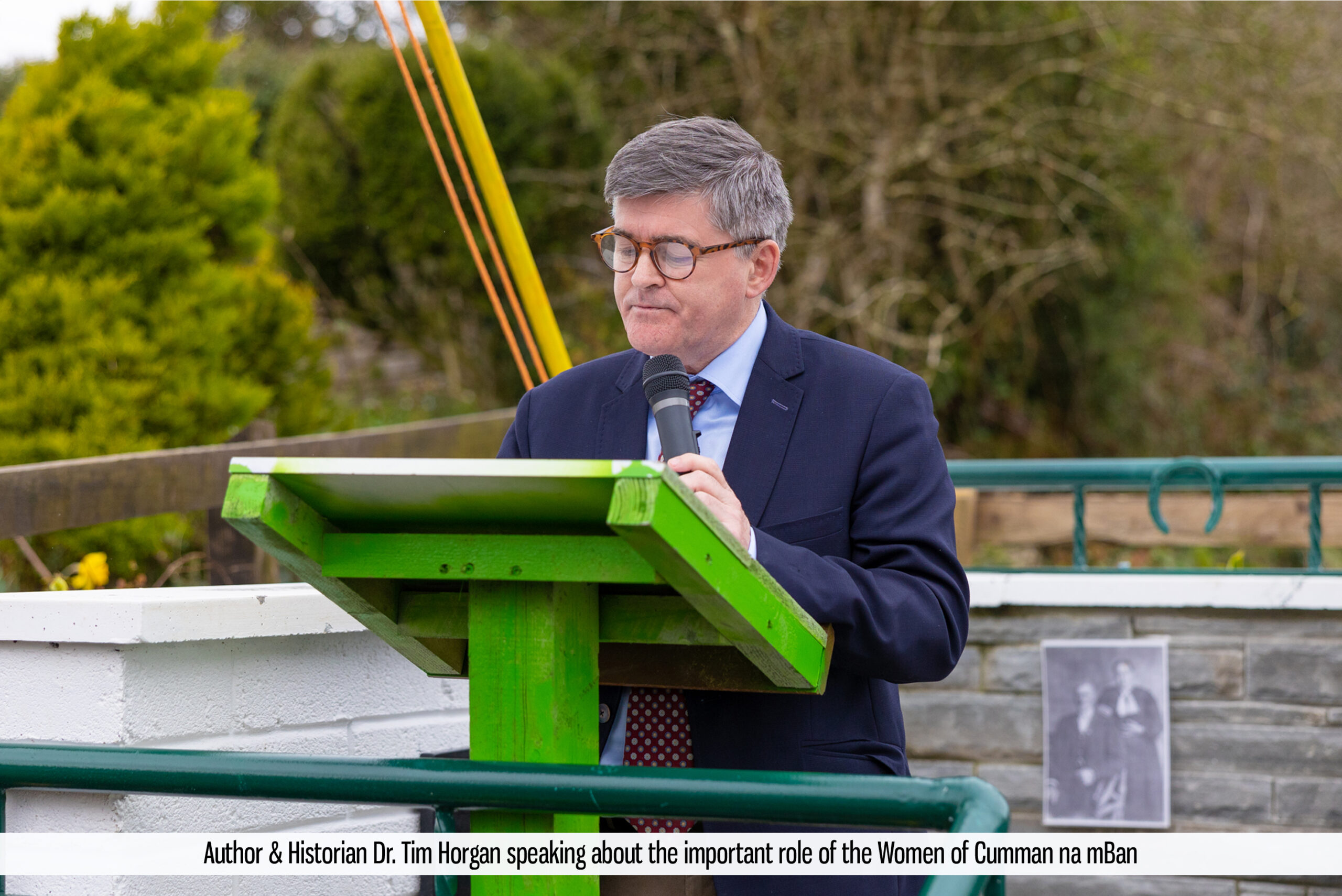
The next speaker was the creator and writer of the film ‘Ballyseedy’, broadcaster Pat Butler, who was welcomed with excited applause. He was introduced by Denis Walsh as follows: “It is a great honour for me to introduce you to our next speaker…the excellent broadcaster Pat Butler. Pat was the man behind the 1997 Documentary ‘Ballyseedy’. An equally shocking and inspirational depiction of the events around some of the atrocities here in Kerry.” We speak a lot about bravery today and Pat Butler showed immense bravery to expose the truth. Many wanted to leave these stories in the past but Pat decided to bring these appalling events to light at time when The Good Friday Agreement was not yet signed. You showed great courage and integrity, ensuring that our heroes endeavours would not be lost to history. For that we are extremely grateful to you Pat, and we are delighted to have you here today. Your attendance shows that your documentary was not just a career event but more a historic journey that you have walked on with us.”
Pat had some very kind words fo the people of Knocknagoshel and commended them for their help in making ‘Ballyseedy’. He described the sense of friendly community in the village with a proud remembering of the past.
The following are extracts from Pat’s speech:
‘It is a huge honour to have been invited here today by Mícheál Walsh to the unveiling of this memorial to Dan Murphy and to Cumann na mBan. Friendship, love and respect brought me here today. For the truth is, that were it not for Mícheál’s contribution to the programme I made some time back – ‘Ballyseedy’ – that programme simply could not have been made…And I’ll tell you why it could not have been made. I had all the answers as to who was responsible for the massacre at Ballyseedy from the ground up to the highest level in the National Army. In order to be able to name and shame those responsible, I needed to know who planned and executed the Knocknagoshel Trap Mine, and be able to name all involved from the ground up to the top of the IRA.”
“Only that symmetry could make it possible to tell both stories in parallel detail. Mícheál Walsh understood that, and bravely decided to share his family story with me, in a spirit of mutual trust. And for that, I am forever grateful. Thank you Mícheál…And yours wasn’t the only family here who contributed to the truth of what happened here in 1923…Thank you all. Today Knocknagoshel remembers with pride, as well it might, the contribution your uncles and aunts made to the defence of the Republic. And only by embracing one’s own story can true healing begin. Civil War results in the poisoning of the well of community. The sad truth is that both sides in that bitter conflict believed that they were the true defenders of that Republic. Only by embracing one’s own story and reaching out to understand, and to forgive the other side, only then can true healing begin….”
“Knocknagoshel turned out staunch, loyal people from way back. Who arose and stood by Charles Stuart Parnell below in Newcastlewest in 1891 when the Party and the people turned against him – who else but the men and women of Knocknagoshel… And when the Republic was long lost in 1923, who nevertheless stood by the Republic to the very end? By March 1923, the Republic was hopelessly lost. At that stage there was no possibility the IRA, the remnant Army of the Republic, could overthrow the Free State Government. Knocknagoshel was the last futile stand of the Irish Republic…Futile? Yes. But all that happened here is part of our national story. It not just needs to be remembered – it demands to be remembered. And community remembrance can mark a new beginning.”
“Today’s unveiling therefore is a family event, a community event, a national event. It’s made all the more important and significant by the inclusion within this memorial a recognition of the role and crucial contribution of the women of Cumann na mBan – a contribution largely written out of history. Women who served with honour in that band of sisters, women who fought for Ireland, and who suffered unspeakably, particularly here, when they were hounded, abused and shamefully assaulted by uniformed men acting in the name of the then Government. Today the flag of Cumann na mBan flies proudly above this memorial – not before its time. The last, great untold story of the Republic is the story of Cumann na mBan. Their recognition here today is a matter of great pride, and I am honoured and to make mention of their bravery, their fortitude and their suffering…
And if those who remember on both sides find common cause – who knows how far we may yet travel towards the all too belated achievement of that Republic, one hundred years later…”
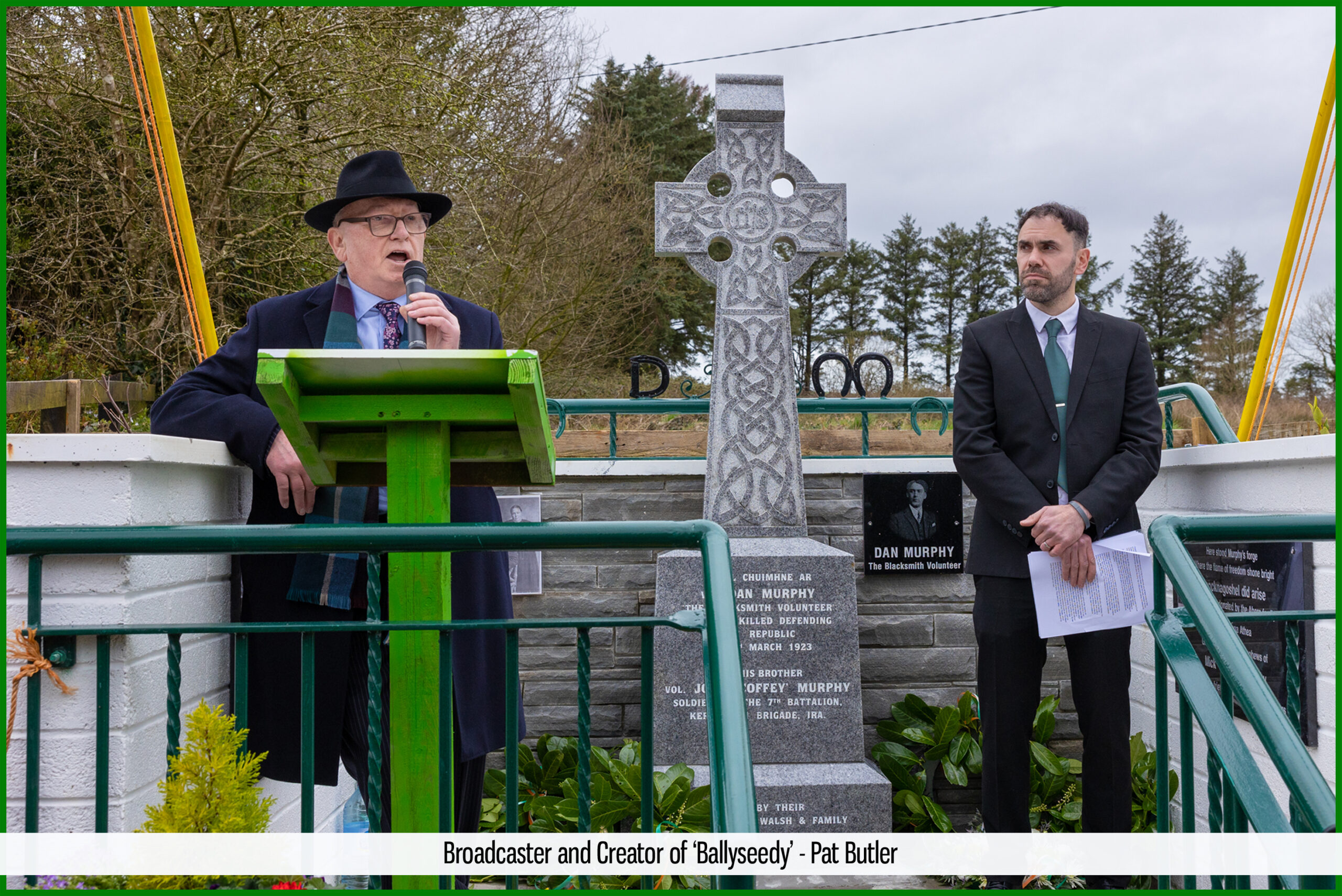
The chairman then made a special tribute to Micheál Walsh for his enormous contributions and endeavours to ensure this day took place and that the monument to the fallen heroes was unveiled. Seamus Ahern, grand-nephew of one of those remembered, then spoke about how proud he was to donate the site where the monument sits and how important it is to remember those who had sacrificed so much.
Denis Walsh then delivered the final oration to Dan Murphy and the following were his words: “I guess we can only imagine what times were like back then, and how the oppressed dealt with adversity. As I went through the history of this time with my father it certainly triggered something… perhaps Micheál’s passion transferred from him onto me. As my mind brought these characters to life I really wanted to go back in time and walk beside them… if only for one day. Of course that is an easy thing to say but to actually possess that resilience and mental fortitude is an entirely different level of courage.”
“If we could now transport our minds back to the morning of the 24th March 1923 and try to place ourselves in Dan Murphy’s shoes. Arrested along with his brother John, tortured and interrogated while knowing that any moment could be his last. Neither brother would talk to these vicious hounds as they gloated over their captured prey. How would you feel were in that situation… as the acute reality… became all too real.”
“Eventually, following hours of heavy-handed brutality, Dan would know his faith, as he was bound by his captors and marched from the village and over to Burke’s field at the site of the explosion. How would you feel knowing, while surrounded by blood thirsty thugs, that each step was a step closer to death. He did this knowing he was paying the eternal punishment for a mine explosion… that was not his doing. Of course Dan was fighting on the republican side but the casing for this mine had been made by his brother John. Dan valiantly didn’t reveal this as it may have resulted in both brothers being murdered. The Freestate Offices had got the wrong man but that was of little importance to Mulcahy’s murdering squad, of Jeremiah Gaffney, Maurice Culhane and William McAuliffe. He showed no fear and did not beg for any mercy or leniency. Would any of us have that mental strength of bravery.”
“The first round of bullets pierced his skin, he went down, but even then he was able to move again onto his elbows, as his final breath drew near. This is how I measure Dan Murphy, a courageous man…a defiant leader, who was willing to pay the ultimate sacrifice for what he believed it…and he did.”
”On that faithful day in March 1923, those fatal bullets echoed across the valleys… and the ground beneath you grew red. You slipped away from this world, hopefully on to another, more deserving of your character and bravery. Your legacy also grew from that day and one hundred years later you remain an important figure in the history of Ireland’s struggle for independence. Your memory and legacy will now be immortalised through this monument. It will forever be carved in stone and will transcend not only Knocknagoshel, but all of Ireland. Dan, you were a fearless leader, a soldier for Ireland and your memory will endure. Wherever you are now and if by some hope you can see us here today, can I say I am proud to be talking about you on behalf of everyone here, and I am prouder still that you are my grand uncle. The honour is ours to be lucky enough to be connected to you in any way, and to know that you gave your life in the hope of a better future for each of us. If you can hear us now Dan……thank you!”
The event concluded with a rendition of ‘The Blacksmith Volunteer’, a song dedicated to Dan Murphy. It was beautifully sang by Charlotte Collins with Lisa Shine on fiddle. The two musicians, both local girls, then sang the event to a conclusion with a wonderful version of Amhrán na bhFiann.
On behalf of the Walsh family, Micheál would like to extend a huge thank you to anyone who helped or contributed in any way to the commemoration, without whom it would not have been such a success.
